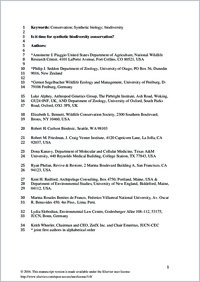Is It Time for Synthetic Biodiversity Conservation?
- Piaggio AJ US Department of Agriculture, National Wildlife Research Center, 4101 LaPorte Avenue, Fort Collins, CO 80521, USA. Electronic address: toni.j.piaggio@aphis.usda.gov.
- Segelbacher G Wildlife Ecology and Management, University of Freiburg, 79106 Freiburg, Germany.
- Seddon PJ Department of Zoology, University of Otago, PO Box 56, Dunedin 9016, New Zealand.
- Alphey L Arthropod Genetics Group, The Pirbright Institute, Ash Road, Woking, GU24 0NF, UK; Department of Zoology, University of Oxford, South Parks Road, Oxford OX1 3PS, UK.
- Bennett EL Wildlife Conservation Society, 2300 Southern Boulevard, Bronx, NY 10460, USA.
- Carlson RH Biodesic, Seattle, WA 98103, USA.
- Friedman RM J. Craig Venter Institute, 4120 Capricorn Lane, La Jolla, CA 92037, USA.
- Kanavy D Department of Molecular and Cellular Medicine, Texas A&M University, 440 Reynolds Medical Building, College Station, TX 77843, USA.
- Phelan R Revive and Restore, 2 Marina Boulevard Building A, San Francisco, CA 94123, USA.
- Redford KH Archipelago Consulting, Box 4750, Portland, ME, USA; Department of Environmental Studies, University of New England, Biddeford, ME, 04112, USA.
- Rosales M Federico Villarreal National University, Avenida Oscar R. Benavides 450, Lima, Perú.
- Slobodian L Environmental Law Centre, International Union for Conservation of Nature (IUCN), Godesberger Allee 108-112, 53175 Bonn, Germany.
- Wheeler K ZedX Inc., Bellefonte, PA 16823, USA; IUCN, Rue Mauverney 28, 1196 Gland, Switzerland.
- 2016-11-23
Published in:
- Trends in ecology & evolution. - 2017
biodiversity
conservation
synthetic biology
Biodiversity
Conservation of Natural Resources
Ecology
Introduced Species
Synthetic Biology
English
Evidence indicates that, despite some critical successes, current conservation approaches are not slowing the overall rate of biodiversity loss. The field of synthetic biology, which is capable of altering natural genomes with extremely precise editing, might offer the potential to resolve some intractable conservation problems (e.g., invasive species or pathogens). However, it is our opinion that there has been insufficient engagement by the conservation community with practitioners of synthetic biology. We contend that rapid, large-scale engagement of these two communities is urgently needed to avoid unintended and deleterious ecological consequences. To this point we describe case studies where synthetic biology is currently being applied to conservation, and we highlight the benefits to conservation biologists from engaging with this emerging technology.
- Language
-
- English
- Open access status
- bronze
- Identifiers
-
- DOI 10.1016/j.tree.2016.10.016
- PMID 27871673
- Persistent URL
- https://folia.unifr.ch/global/documents/250960
Statistics
Document views: 27
File downloads:
- fulltext.pdf: 0
